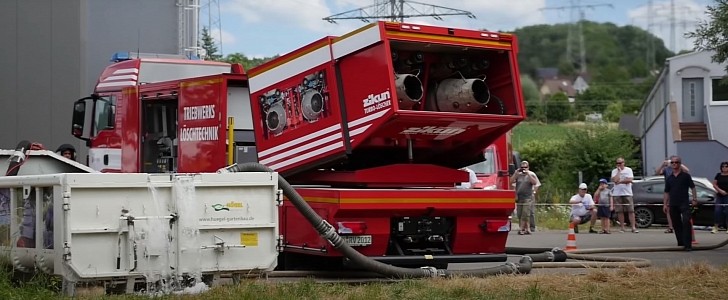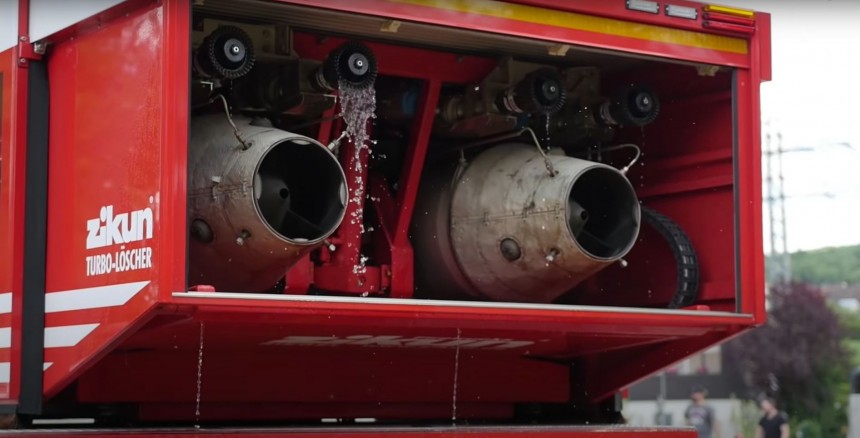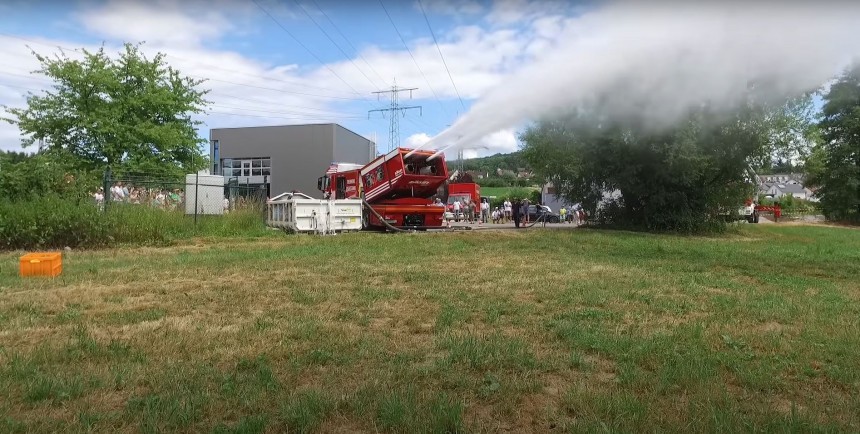Wildfires have sadly become a common occurrence. Our world is rapidly changing, and it seems like we can’t do enough to stop this dangerous phenomenon. However, this huge fire engine is proof that regulations work, and you’ll find out soon why we’re saying this. We should establish some similar ones in the U.S. too. That’s, of course, true only if we intend on taking care of our surroundings. But now, here’s the Turbo-Loscher II.
When you run a chemical plant in Germany or the EU, some very harsh regulations need to be respected, evaluated every year, and updated if that’s required. A couple of months ago, we were telling you about Big Wind which we called “a firefighter’s dream.” That vehicle was a fantasy that did come true for engineers and industry experts. It helped with keeping Kuwait’s environmental disaster under control and proved that limits are nothing to worry about when humans cooperate in a professional yet unrestricted manner.
But coming back to our star – the Turbo-Loscher II – we need to understand why vehicles such as this huge fire engine are so common in Europe. Big Wind was developed in Hungary after international cooperation was made possible and because politicians listened to experts when the topic of properly suppressing fires became a huge worry. Europe dealt with major disasters at home and abroad. Those lessons were eventually transformed into public policy.
Germany, being an industrialized country, took the matter way more seriously. That’s why we can find some of the world’s leading companies in the European nation. They don’t joke around when safety is involved. The Germans have strict rules when fire hazard is involved. This is why BASF, a company that currently has over 16,500 employees in North America, was forced to make investments to prevent a disastrous event from happening.
Because safety is of utmost importance, to cover all that area and all those important structures, BASF has a fleet of 46 vehicles that deal with fires in different ways. Some come with foam, others with fine sand, while some are downright impressive. The jewel in the crown is the Turbo-Loscher II. This fire engine is capable of spraying about 2,110 gallons (8,000 liters) per minute!
It weighs 30 tons, has a length of over 32.8 feet (10 meters), and it has an engine that puts out 492 HP (500 PS). The amazing factor is that it has two jet engines installed on its backside. These dissipate water so efficiently and so fast that it effectively gets turned into mist. Considering chemical fires are extremely dangerous and can spread rapidly, this massive fire engine can keep them under control while other ground units find the best solutions to implement.
Thanks to its two powerful jet engines, the vehicle is capable of covering an area of about 3,760 square feet (350 square meters) while the spray distance can go beyond the 328 feet mark (100 meters).
The Turbo-Loscher II can also turn into a powerful ventilator after emptying its water tank. This will cool the affected area and dilute the toxic gasses to allow firefighters to properly intervene.
Finally, the original Turbo-Loscher also used two jet engines to fight fires, but it only had a capacity of 1,585 gallons (6,000 liters) per minute. Even if it’s gotten old, it’s still serviced and remains a backup option in the BASF fleet of fire engines, fire trucks, and other vehicles.
But coming back to our star – the Turbo-Loscher II – we need to understand why vehicles such as this huge fire engine are so common in Europe. Big Wind was developed in Hungary after international cooperation was made possible and because politicians listened to experts when the topic of properly suppressing fires became a huge worry. Europe dealt with major disasters at home and abroad. Those lessons were eventually transformed into public policy.
Germany, being an industrialized country, took the matter way more seriously. That’s why we can find some of the world’s leading companies in the European nation. They don’t joke around when safety is involved. The Germans have strict rules when fire hazard is involved. This is why BASF, a company that currently has over 16,500 employees in North America, was forced to make investments to prevent a disastrous event from happening.
It can get misty
The entity has multiple plants globally that deal with various materials, but a particular one in Ludwigshafen, Germany, is making sure important chemicals are produced safely. There are over 41,000 employees and trainees on site on every single working day that work in 2,000 buildings spread across an area of 3.8 square miles (10 square kilometers). This amazing factory also serves as headquarters for BASF.It weighs 30 tons, has a length of over 32.8 feet (10 meters), and it has an engine that puts out 492 HP (500 PS). The amazing factor is that it has two jet engines installed on its backside. These dissipate water so efficiently and so fast that it effectively gets turned into mist. Considering chemical fires are extremely dangerous and can spread rapidly, this massive fire engine can keep them under control while other ground units find the best solutions to implement.
It gets the job done
The Turbo-Loscher II isn’t a fire truck because it doesn’t come with an aerial or ground ladder, and it doesn’t have specialized equipment for ventilation, entry, and rescue operations. Its main role is to serve as the first responder on a scene that’s most likely to devolve into a tragedy.Thanks to its two powerful jet engines, the vehicle is capable of covering an area of about 3,760 square feet (350 square meters) while the spray distance can go beyond the 328 feet mark (100 meters).
Finally, the original Turbo-Loscher also used two jet engines to fight fires, but it only had a capacity of 1,585 gallons (6,000 liters) per minute. Even if it’s gotten old, it’s still serviced and remains a backup option in the BASF fleet of fire engines, fire trucks, and other vehicles.











